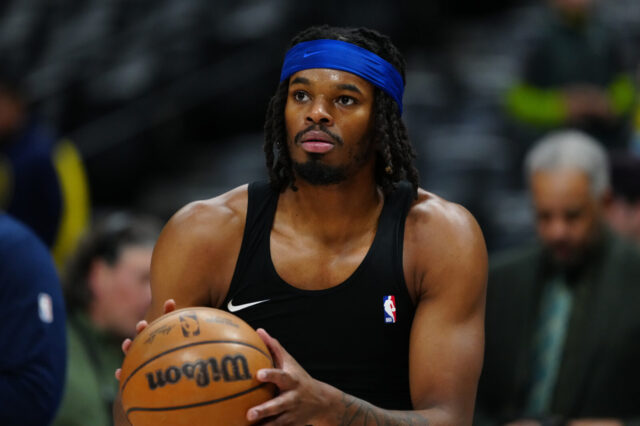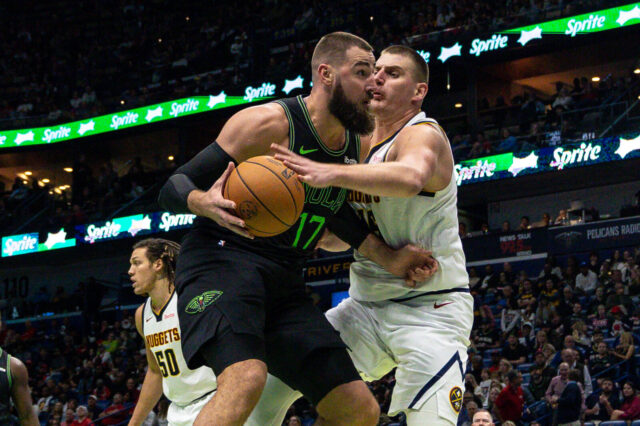Last week, Gary Harris signed a 4-year, $74 million dollar extension with the Denver Nuggets that has an additional $10 million in bonus incentives. The full details of those incentives have not been made public but rumors around Pepsi Center are that the incentive targets are steep and include both team and player targets. So the final number is likely to land closer to $74 million than $84 million.
Nonetheless, that type of money means the Denver Nuggets are placing a lot of faith that Gary Harris will not just continue to play at the level he reached in his third season in the NBA, but that he will continue to grow and add pieces to his game. But what exactly does improvement from Harris look like? He’s already one of the league’s best high-volume shooters, one of the best cutters in the league, and a perfect fit next to Nikola Jokic, so what is a reasonable expectation for Harris going forward?
Let’s take a closer look in this week’s spotlight.
This content is no longer available.
The first and most obvious way that Harris can – and perhaps more accurately, must – improve is on the defensive end of the floor. Harris has a reputation as a three-and-D prototype that goes all the way back to his college profile but at the NBA level, that reputation outpaces his actual on-court production. Last season, Harris had a -1.7 defensive box plus-minus and a -2.37 real plus-minus. That last mark ranked Harris 85th out of 93 shooting guards in that metric.
Catch-all metrics like RPM and DBPM are not gospel and shouldn’t be relied upon too heavily for any real analysis but it is worth noting that Harris ranked so poorly in both categories. You can combine those metrics with the fact that Denver’s defense improved by over 6 points per 100 possessions when he was off of the court and it’s clear that something was wrong with Harris’s defense last season.
Per Synergy, Harris was below average at defending almost every type of action. He was especially bad in three of the four most important categories, off screens, hand offs, and isolations.
This content is no longer available.
Some of these issues were team-wide. Denver as a team ranked in the 30th percentile or below in all categories, hinting at broader issues than any individual player. So it’s especially important when looking at these stats to question just how much can be gleaned from the raw stats alone with regards to Harris’s defensive potential. However, there are some physical limitations to his game that might not be correctable.
Harris gets blown by a lot in isolation. So much so that certain players seem to target him over and over, and not just the elite crop of guards like Russell Westbrook who target every defender. Jordan Crawford seemed especially eager to go at Harris, as did Dennis Schroder. In the clip below, watch how easily guys are able to blow past Harris without using especially impressive moves.
Harris is strong for his position and has really strong hands that help him disrupt players that try slow, power moves against him but he’s not very quick footed. In isolation this leaves him vulnerable to quicker guards like in the clips above. Off screens and on closeouts, that slow recovery speed causes problems, especially compounded by the fact that at 6’ 4” he isn’t very tall for his position.
Also compounding these deficiencies is the fact that he has a tendency to roam far too often on the defensive end. It’s hard to tell what is scheme and what are his own habits but plays like this one happen far too frequently, where Harris ventures too far off of a shooter to recover yet provides almost no real help defending the ball. Longer and quicker guards can get away with these types of gambles. Harris cannot.
Many of Denver’s guards have said that the new defensive scheme, which puts more pressure on the bigs (especially Nikola Jokic) to play up higher toward the level of the screen, allows for defenders to play more aggressively containing the ball on pick and rolls and off of screens. So perhaps to some extent Harris has fallen victim to Denver’s defensive style. But whatever the case, Denver will need Harris to become a lockdown defender if they plan on being anything more than a 40-win team.
Offensively, Harris brings a lot to the table. He’s improved his three-point shot every single season and Nuggets fans are mostly confident that he will be closer to the 42% three-point shooter that he was last year than the 30% shooter he was in his first two seasons. That’s a pretty fair assumption considering how consistent Harris was last year but it’s at least worth noting that a regression is still a risk, however small. Harris is also the team’s best cutter and one of the best cutters in the entire NBA. Those two skills made him especially valuable when playing alongside Jokic bu left him much less effective when Jokic wasn’t on the court. As a team, the Nuggets had a +6.3 net rating with both Jokic and Harris on the court but a -6.6 net rating when Harris was on but Jokic was off, per nbawowy.com.
Last year, Harris began adding a bit more playmaking to his arsenal, especially out of the pick and roll. This is the next big leap for Harris offensively and it may come with some growing pains. Part of Harris’s value on the offensive end is that he doesn’t make a ton of mistakes or force a lot of shots. As he looks to become more of a playmaker he’ll have to test and even push the limits of what he is capable of, at times likely crossing the line and making bad reads. Figuring out how to balance being more aggressive with staying in control will likely take some time but Denver has enough playmakers on the roster right now that the burden for him to experiment should be pretty small.
In the pick and roll and on dribble handoffs (DHO), Harris is great at pulling up for three when the defense goes too far under the screen. It all starts with his footwork, where he does a great job of going right into his gather the first moment that he senses the defense fly too far out of position. He and Jokic have great chemistry in this regard in that Jokic anticipates both Harris’s angle coming off of the screen and which way the defender is trying to go. Quick reads open up just enough space for Harris to take the quick open three in rhythm.
Harris is also great at getting all the way to the basket off of DHOs and pick and rolls and very good at finishing through contact or contorting his body to finish around contact. He has sneaky hops when given a full head of steam and recognizes open lanes early as he turns the corner, exploding toward the rim for highlight dunks.
He is also pretty good at knocking down that one-dribble mid-range shot when he is run off of the three point line but doesn’t have an angle to the basket. Where he struggles is in making passes out of the pick and roll in that in-between range. A majority of his turnovers on offense come off of plays just like the ones below, where the defender – usually the center – manages to play in-between just long enough to make Harris hesitate.
This is where Harris can really grow as a playmaker. Elite pick and roll players have a great feel for the timing of the play which sometimes requires the ball-handler to slow, stop, and speed up at just the right time in order to prevent the big from playing in-between the ball and the roll. Harris tends to play at one pace and it makes him a bit too predictable.
Perhaps this is the step Harris preparing to make offensively this season. Toward the end of last season, Harris began setting new personal records for assists and showed flashes of developing skills as a playmaker. He wasn’t a pick and roll player in college so these skills are all new to him. Fortuantely, Denver doesn’t need his playmaking in order to create a great offense during the regular season but if he can grow in this area, Denver adds another threat to their offensive attack and adds another player tht they can rely on to create plays, not just finish plays.
This content is no longer available.
On an episode of the Locked On Nuggets podcast last week, I described Trey Lyles as a guy that has a lot of the big skills to be a very good player but lacks a lot of the smaller, more routine skills. This is a perfect example. Juancho Hernangomez is a 40% three-point shooter and especially deadly from that right wing, a spot that is dubbed by Scott Hastings as “Juancholand.”
In the clip below, Lyles is put in the position to make a decision between passing to a wide open Juancho standing in Juancholand or drive into a crowded paint. In real time these decisions are more difficult than on replay but this is still the type of read that should be easy for an NBA level player.
This content is no longer available.
36.8
That is the percentage of Paul Millsap’s field goal attempts that came from behind the three-point arc in the preseason, according to nba.com. Over one-third. Last season just 24.8% of Millsap’s attempts were three-pointers and the year before that it was just 21.8%.
This can probably be chalked up to small samples sizes and the fact that Millsap go really hot from deep in the team’s first preseason game but it might also be a sign of a player that has yet to find his spots on the court and in the flow of the offense. Jokic is also taking a larger percentage of his shots from deep compared to last season. So this might just be the role each are asked to play in order to keep the paint open for drives and cuts but my guess is that number is still a bit higher than the Nuggets would like.
This content is no longer available.
Mason Plumlee | DEN @ LAL | 13 points, 14 rebounds, 6 assists
Plumlee has been a revelation this preseason. He’s been everything he was brought in to be. He is (almost) a facsimile for Jokic when Jokic isn’t on the court and he’s a high-energy, tough big when that’s what is called for. He’s playing more confident and more physical than last season and it appears he has figured out his role on the team, an the team has figured out how to use him.
Nikola Jokic | DEN @ SAS | 19 points, 7 rebounds, 4 assists
This was the most Joker-like statline of the season for Nikola. For some reason, he always plays well against the Spurs. The offense started flowing through Jokic more and more, starting with this game and carrying over into the OKC game.
Will Barton | OKC @ DEN | 26 points, 5 rebounds, 3 assists, 3 steals, 1 block, 4-6 3FG
You could make the case that Will Barton deserved the game ball in San Antonio when he shot 4-6 from deep and poured in 16 points. Either way, he’s entering the season on a hot streak.
There is something to be said for Denver having five different players earn game balls in five preseason games. It’s a testament to how balanced this team is and how on any given night, any player can step up. Jokic and Millsap will likely earn the lions share of these, but they won’t be asked to carry the entire load every single night.


